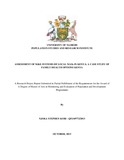| dc.description.abstract | The overall objective of the assessment was to determine the status of the FHOK M&E system
and its contribution to the improvements of the programme. Specifically, the assessment was
aimed at: determining the extent to which the FHOK M&E system meets the established
standards; identifying strengths and gaps of FHOK M&E system; and determining how the
products of FHOK M&E system have been used to improve the programme.
The assessment employed descriptive research design which allowed for description of the
current FHOK M&E system and helped to establish strengths and gaps which were fundamental
to the realization of research objectives. The assessment adapted approaches used by Ogungbemi
et al. (2012) in assessing Nigeria's HIV M&E system and Independent Evaluation Group (2013)
in assessing International Finance Corporation and Multilateral Investment Guarantee Agency
M&E systems. The assessment operationalized FHI 360's Participatory M&E System
Assessment Tool that condenses the 12 components of an M&E system into 8 domains,
programme-level use. The target population was 17 service delivery sites. 3 sites (Kisumu,
Eldoret and Kakamega) and 17 respondents were purposively sampled to take part in the
assessment. The head office was also involved in the study. Data was collected through
document review, Key Informants' Interviews, discussions and observation. Data was analyzed
both quantitatively and qualitatively to produce the results.
Overall, FHOK M&E system scored 148 out of 240 which is 62 percent. This is an aggregated
score from all the 8 components. Scores vary from component to component with data analysis
and use and evaluation (a tie) scoring the highest at 79 percent and documentation recording the
lowest score at 43 percent. The assessment identified key strengths of FHOK M&E system to
include: adequate resources allocated for M&E work (M&E budget was 8 percent of overall
2015 programme budget), alignment of indicators to donor and national indicators, use of
standardized data collection tools, presence of M&E databases to track progress, continuous data
analysis and use and use of evaluations to improve programme. Key gaps that were identified
include: documentation of M&E procedures, inadequate evaluation and research capacity of
M&E staff, corrections are not made after data quality assessments, evaluations are largely
donor-driven and no component of FHOK M&E system has been shared in a conference or
published in a peer reviewed publication. In terms of contribution of FHOK M&E system to
programme improvement, it was observed that FHOK M&E system has been vital in tracking
progress against targets, accounting to donors and stakeholders, reviewing and improving
programme implementation strategies, designing new innovations, ensuring that the right target
group is reached and strengthening efficiency of FHOK programme.
The following components of FHOK M&E system were noted to be strong: resources and
capacity building, data quality systems, data analysis and use and evaluation. However,
documentation and data verification components presents opportunities for strengthening. The
ongoing process of reviewing the M&E plan should directly address the documentation aspect as
has been identified in the other two assessments that were conducted in 2014. With continuous
management support, resource allocation and assessment for improvement, FHOK's M&E
system can be an exemplary system for adoption by other NGOs.
The key recommendations that were made, basing on the findings include: the need to update the
M&E Framework into an M&E Plan and align it to the new Strategic Plan, the need to document
all aspects of FHOK M&E system in the updated M&E Plan, projects to draw clearer and more
specific M&E budget lines, the M&E team to conduct more regular data verification exercises
and make necessary corrections prior to sharing of data, and the need to build targeted and
customized M&E capacity of field-level staff. | en_US |

